This next topic is electric! Types of electricity, to be specific. My goal is to walk through a subject that is somewhat technical and explain it more in layman’s terms. I could use some feedback on whether or not I succeeded. Also whether or not this is remotely interesting vs. being dry as dirt.
Perhaps this information would be helpful as part of the Howie page as reference for anyone learning about electrical systems for mobile living. I may work on adding it there in the future.
OK, let’s get started.
Most houses have both AC (alternating current) and DC (direct current) power. Side note – “AC” also stands for air conditioning, which is also being discussed right now in Howie since it is late spring in Texas, but for this post I’m talking about electrical current. The exact mechanisms behind AC vs. DC aren’t important for our purposes. The main point is that AC = standard outlets and DC = batteries.
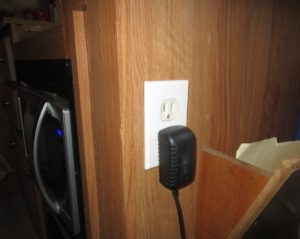
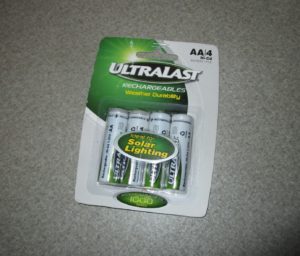
AC is usually used for higher voltage appliances like a heater or microwave oven, while DC generally powers smaller items like a phone or flashlight. As far as I know it doesn’t have to be this way, that’s just how our systems are configured.
More examples: USB plugs and cigarette lighter-style plugs are DC. Computers and printers have a box along the power cable that changes the AC power from the outlet to DC power at the device. Some dryer outlets are a different style AC plug that can deliver more current.



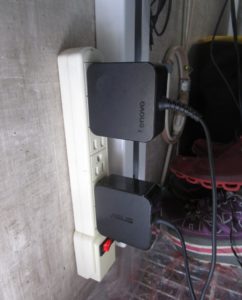

People who live in a “normal’ house usually only see the AC side of things, which is the power coming from the utility company into the house and out the plugs. It’s not as obvious that there is some AC-to-DC conversion happening, like with the computer and printer cables above.
In an RV/travel trailer, the DC side is much more relevant to day-to-day living. While plugged into shore power, like a post at an RV park, you have AC power coming in like a house and you don’t notice that there are separate AC vs. DC systems.
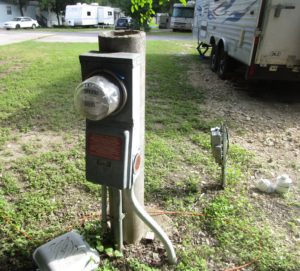

However, when the travel trailer/RV is unplugged (also called off-grid), the batteries are the sole power source. Batteries are always DC. So the DC systems in your mobile abode will still have power, for as long as the batteries have power.
Side note – a Tesla Powerwall is an example of a battery bank that can be installed in a house. With one of those, you too will still have electricity when the grid goes down.
While an RV is unplugged, the AC systems require an inverter to change the DC battery power to AC. Anyone living in an RV will probably figure out pretty quickly what items run on AC vs. DC when you aren’t plugged in (unless you have an inverter that automatically kicks on, but our 2007 travel trailer didn’t come with one of those).
It’s worth noting that changing power from AC to DC (and vice versa) results in some amount of power loss, so part of system design is trying to minimize that. There are wire size considerations. And plenty of other details that I won’t get into here, as this is meant as more of an overview explanation.
Here are the different types of electricity in Howie and what they power:
- 120V AC loads = water heater and anything plugged into the AC outlets
AC outlets power a lot of things including laptops, ceramic heaters, footpad heater, microwave, induction cooktop, Instant Pot, toaster oven, “Billy” water kettle, electric toothbrush, external DVD player, John’s tool chargers, rechargeable batteries, dehumidifier, bike headlamp, any USB chargers that are plugged into standard AC outlets, etc.
- 12V DC loads = all lights (LED), fridge (2 fans and the light), stove fan, bed up/down motor, bathroom fan, trailer runaway brake, propane alarm (until it’s removed/disconnected), radio, water pump when we’re not hooked up to water, USB/DC plug outlets
The USB outlets can run the white noise machine and charge phones, LED light bars, TPMS monitor, drone batteries, iPod, Garmin InReach, handheld Fenix light, waist belt light, etc.
- 24V DC connections = incoming solar, inverter/charger, converter to 12V, refrigerator compressor
Here’s the flowchart we put together (my first online flowchart creation, courtesy of LucidChart). It’s rather full of details so it might clarify a few things or just confuse people. Feel free to send questions.
Oh, to head off the most obvious question, “Disco” refers to a disconnect. I just like the disco term; it reminds me of Star Trek and it fits in the boxes better.
Our various “states of being” (electrically speaking) include these situations:
- Driving down the road, obviously not plugged into anything. Solar energy is charging the batteries, and in fact we do some of our best battery charging while traveling. DC energy is available for 12V and 24V loads. If we turn on the inverter (manual on/off switch), we also have AC energy available, but we tend to leave it off except for lunch breaks (microwave heating) and using excess energy to power the water heater.
- Boondocking without hookups. This is similar to driving down the road, except we’re more likely to turn the inverter on. It takes a small amount of power just to run the inverter, so we leave it off if we need to conserve energy. Our main focus is keeping the refrigerator running; always want to make sure we have enough for that.
- Parked at an RV park with the option to plug into the grid. When we plug in, we can use the AC appliances without concern about running down the batteries. There is a 30 amp limit to what we can have turned on at any one time. Some parks charge by the kWh for electricity usage (especially with month-to-month stays instead of overnights).
The main reasons we plug in these days:
- Run a heater for more than a couple hours – this was the case in January/February in cold and cloudy South Carolina
- Several consecutive days with zero sunlight (# of days depends greatly on how much we plan and scale down our energy usage and how much filtered light gets through the clouds and still charges the batteries at least a little)
- Need to charge up the batteries from the grid; not something we often do, but it’s nice to have that option
As of today (early May in Austin) we have gone 25 straight days without plugging in. In case anyone hasn’t been following along from the beginning, we also have zero propane in the house.
The solar panels get about 4 solid hours of sun in the afternoon. There have been a few cloudy/rainy days but many more sunny ones. Every day we heat water, cook breakfast and supper, run a small fan, and charge phones/laptops. The refrigerator is on much of the time because the outside temperature has started hitting the low 90’s. Most of the time (right now, at least) we have zero limits on energy usage and the batteries are frequently at max charge by the end of the afternoon.
We’re about to install a heat pump and with any luck we’ll soon have air conditioning available, so that might push us to plug in again. Or not. Stay tuned…
Also stay tuned for a future post where I get into the electricity usage numbers and solar/battery sizing. I’m sure at least one person has been wondering about that (or not)!
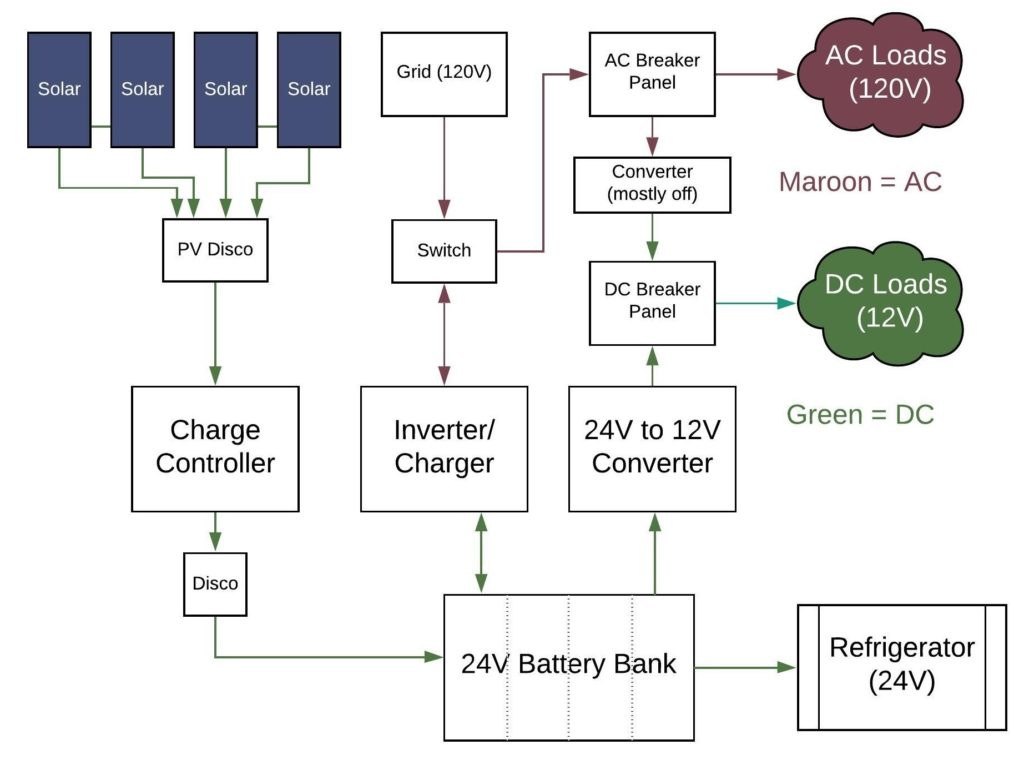
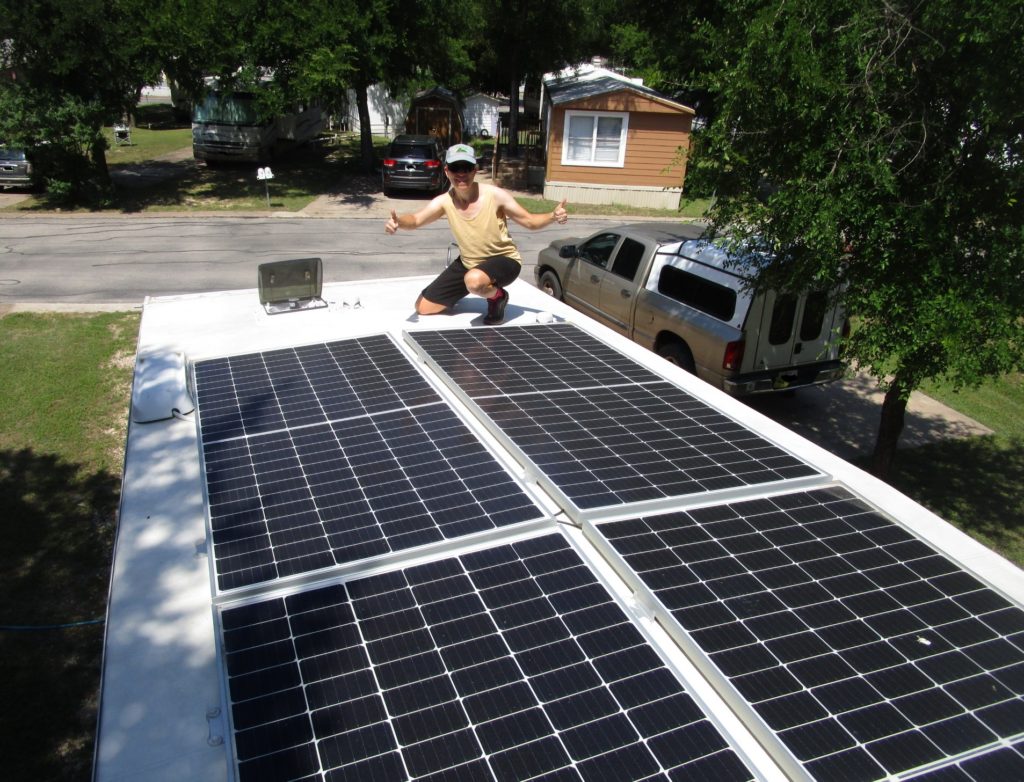
Not too complicated, not too simple, just right.
And now I’ll get too complicated. I have a question about the stack up of batteries and the usage of multiple converters. You’re doubling up 12 volt batteries to make a 24 volt stack. But then, for many items, you convert that 24 back down to 12. What’s the loss of that stage? Then you take that 12v DC and convert it up to 120v AC. That has inefficiencies as well.
Could you instead tap the center of your stack of batteries, and get 12 volts directly? That would save you the 24 volt to 12 volt down-conversion on your 12 volt DC circuits, including those that then later get up converted to 120 volts AC.
It would, of course, depend upon your typical end maximum expected current drawers, but perhaps a stack of three batteries from ground to 12 volts, with just one battery from 12 to 24 for the one circuit that needs 24 volt DC directly, might yield higher overall efficiencies? Or simply run the whole DC system at 12 volts with a 12 to 24 volt DC step up for the refrigerator?
Kurt,
Here my thoughts regarding your ideas.
There are pros and cons to using a 24v (or 48v) instead of using a 12v battery bank: You are correct that using a 12v battery system eliminates the need for a 24v to 12v dc-dc converter to run 12v dc appliances. It really depends on how many DC loads you need. If you only have a few loads, using a higher voltage battery allows using smaller wiring between system components 24v means 1/2 much current for the same amount of Watts. Why convert DC to AC? Well, if you can find RELIABLE DC versions for all your loads, you wouldn’t need AC, but let’s be realistic, it is a lot easier to find durable 120v AC appliances than their 12 v DC counterparts. A lot of 12v are pure junk. There is some efficiency loss in converting, but it’s easy to compensate for and actually cheaper to find good 120v ac appliances. You don’t want to tap 12v from the middle of your 24v battery bank, especially if you use Li-ion batteries as this will cause the battery cells to discharge unevenly which is bad for battery life.
Marc
Hi Kurt!
As Marc mentioned, we want to evenly charge and discharge all four batteries together, not use one or two for some applications and not the others. According to John’s research, this will maximize battery life.
Also to add a slight correction – the inverter is connected directly to the batteries, so it takes 24V DC and inverts it to 120V AC (no 12V involved).
John designed the system around 24V to reduce wire sizes. Our 12V DC loads are small compared to the 24V and 120V loads, so I don’t believe we’re losing much with the 24V-to-12V converter.
Thanks for the questions!
-Marcy
Disco!! Thanks Marcy
Hi Marcy,
I think your write up is pretty clear. I’m ordering the parts I need from my dyi home solar backup generator project today and I will share my system design with you and John soon. I am going to use a 24v dc battery system (a 24v BattleBorn, 50Ah), a 100v/30A EPEVER 12v-24v Smart Charge Controller, a Giandel 2000W/4000W peak Pure Sine Inverter and assorted meters, switches, fuses and bus bars and the used AstroPower 100W PV modules I acquired while helping John. I debated whether to include a 24v to 12v converter for 12v loads, but at home, I don’t really have any 12v dc loads, so I will leave that out for now, but it would be easy enough to add it for someone who wants to use this system on an RV.
Cheers,
Marc
Hi Marc!
That sounds like a fun project and we look forward to hearing more about it. How does it interact with the grid (if at all) – some kind of switch? Our travel trailer has an “ATS” transfer switch, but we also don’t have a permanent connection to the grid.
Thanks for your comments!
-Marcy
Hi Marcy,
My solar generator project is strictly ‘off-grid’. It won’t be connected to my home’s electrical service. When I need power during an outage, I will simply plug in appliances into my generator.